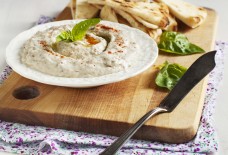I Thought I Hated Cauliflower Until I Fried It the Egyptian Way
SOURCE: GREATEST
BY: JESSICA ESA
Cauliflower: bland and inferior to broccoli in every way. Or so I thought.
For a long time, even cauliflower cheese (the florets baked and smothered in cheese sauce) wasn’t enough to convince me otherwise. We were often served mushy boiled cauliflower in school, and the soggy mess turned me off the white, bulbous brassica for years after graduation.
My father, who grew up in Egypt eating and making food that’s a world away from the bland fare of school lunches, never misses a chance to prove me wrong. But I was skeptical — surely even he couldn’t improve cauliflower. It took years of coercing on his part, but when he told me his cauliflower preparation was spicy and fried with a satisfying crisp crunch — the opposite of everything cauliflower represented to me — I had to give his recipe a try.
My dad’s Egyptian spiced and fried cauliflower takes a cruciferous vegetable that’s bland, even in color, and adds complex layers of flavor and fragrance through a trio of aromatic spices that dance on your tongue: cumin, coriander, and turmeric. The spices add a lively scent and a deep color, one that attracted me to the dish long before I took my first bite.
And oh — that bite!
A crispy, golden-brown battered shell now surrounds the cauliflower florets. The golden shell is speckled with eye-catching flecks of green and red, like emeralds and rubies, finishing with the soft (but never soggy!) cauliflower hidden inside. It’s unrecognizable from the boiled florets I ate at school and takes the humble cauliflower to new heights, alongside other fried vegetable greats like okra fries and tempura.
It was a delight to find that my dad’s faith in this cauliflower recipe was not misplaced! It changed my approach to cauliflower forever, a transformative method that adds everything plain cauliflower lacks: a deep tangy and aromatic flavor, a colorful exterior, and a satisfyingly crispy texture.
If you struggle to see the appeal of cauliflower, or if you outright hate it, believe me, I get it. But this simple and quick recipe might just be the one to change your mind.
And if there’s one thing I’ve learned from my dad (other than how to make the best fried cauliflower), it’s that no matter what your most hated food is, there’s probably a way to prepare it that will change your mind.
Ingredients
- 1 teaspoon salt (or to taste)
- 1 medium head cauliflower
- Vegetable or canola oil for deep frying
- 1 cup all-purpose flour
- 1 cup milk
- 1 large egg
- 1 tablespoon finely chopped parsley (optional)
- 2 cloves garlic, minced (or 1/2 teaspoon garlic powder)
- 1 teaspoon baking powder
- 1 teaspoon ground cumin
- 1 teaspoon ground coriander
- 1 teaspoon ground turmeric
- 1/2 teaspoon black pepper (or to taste)
- 1/2 lemon, for garnish (optional)
Instructions
- Combine salt and 1 quart water in a medium saucepan and bring to a boil. Fill a large bowl with ice water and set aside. Separate cauliflower into bite-size florets and give them a wash.
- Submerge cauliflower pieces in the boiling water and cook for 4 minutes. Transfer them to the ice bath. (This will parboil them, softening them without losing their crunch. Keep an eye on any smaller pieces and remove them early if you need to.)
- While cauliflower parboils, start heating 2–3 inches of oil in a large, high-sided pan suitable for frying.
- Whisk flour, milk, egg, parsley (if using), garlic, baking powder, and spices in a large bowl until mixture is the same consistency as pancake batter.
- Check if oil is ready by dropping a tiny dollop of batter into the oil (if it bubbles and fries immediately, it’s ready), or use a thermometer (the ideal temp range for frying is 350–365°F, or 176–185°C).
- Completely coat cauliflower florets in batter. When oil is ready, work in batches to carefully place a few florets into oil at a time. Once they’re golden brown and crispy, remove them with a spider skimmer or slotted spoon and place on a paper towel until ready to serve.
Optional: Serve with a squeeze of lemon and some parsley on top. You can also add a side of tahini for dipping.
Make sure not to fry too many florets at once or you’ll end up with one giant batter ball!
Jessica Esa is a freelance writer from the UK and spends her time between Europe and Asia. She specializes in writing about East Asian travel, culture, and food and also manages the website Books and Bao with her partner.








